Keywords
|
| Region of interest, Compression, SPIHT algorithm, Medical images, Wavelet |
INTRODUCTION
|
| Digital Image compression is the process of reducing the amount of data needed to represent a digital image. This is done by removing the redundant data (i.e. the data which is more than needed).After storage or transmission of the compressed image decompression is performed to reconstruct the original image. The main objective of image compression is to decrease the number of bits required to store and transmit images without any loss of information. The various applications of image compression are televideo- conferencing, remote sensing, document and medical imaging, FAX(Facsimile transmission) ,hazardous waste management applications. Compression can fit more data in small memory and thus reduces the memory space required as well as cost of managing data. |
| Data is the one by which information is conveyed .For a given information various representations may be used and each representation have different amounts of data. Some representation may have data which do not convey any useful information. These representations are called data redundancy. If the redundancy is removed compression can be achieved. If two data sets have same information carrying units (i.e.) bits in the data sets. The data redundancy of first data is given by RD=1-1/CR. The value of CR= n1/n2. CR is called as the compression ratio. The data redundancy are of three types namely coding redundancy, interpixel redundancy, psycho visual redundancy. The types of compression are |
| 1. Lossless compession |
| 2. Lossy compression |
| Lossless or Error free compression provides compression ratios ranging from 2 to 10. It is applicable to binary and gray scale images. The various applications are digital radiography, processing of satellite imagery. Lossy compression method can achieve high rates of compression. The methods to perform lossy compression are Transform coding, Wavelet coding, Lossy predictive coding. The image compression standards are sanctioned by ISO(International Standard Organisation).and consultative committee of international telephone telegraph(CCITT). The various image compression standards are |
| • JBIG1 |
| • JBIG2 |
| • JPEG-LS |
| • DCT based JPEG |
| • Wavelet based JPEG2000 |
| Nowadays JPEG 2000 is mostly used because it supports lossless and lossy compression of single component . The main advantage of JPEG2000 over other standards, First, it would addresses a number of weaknesses in the existing JPEG standard. Second, it would provide a number of new features not available in the JPEG standard . |
LITERATURE SURVEY
|
| Seyun Kim, Student Member, IEEE, and Nam Ik Cho, Senior Member, IEEE,’ Hierarchical Prediction and Context Adaptive Coding for Lossless Color Image Compression,’ IEEE TRANSACTIONS ON IMAGE PROCESSING, VOL. 23, NO. 1, JANUARY 2014 |
| This paper presents a new lossless color image compression algorithm, based on the hierarchical prediction and context-adaptive arithmetic coding. For the compression of an RGB image, it is first transformed into YCuCv color space using an RCT. After the color transformation, the luminance channel Y is compressed by a conventional lossless image coder. |
| Jonathan Taquet and Claude Labit ,’ Hierarchical Oriented Predictions for ResolutionScalable Lossless and Near-Lossless Compression of CT and MRI Biomedical Images,’ IEEE TRANSACTIONS ON IMAGE PROCESSING, VOL. 21, NO. 5, MAY 2012 |
| This paper has shown that, even if providing resolution scalability,some compression improvements could be obtained on noisy native medical images both in lossless and NLS modes compared with the reference algorithms. The least square optimization has allowed us to boost the prediction on smooth images, where HOP was not really efficient. |
PROPOSED ALGORITHM
|
| In this project, Image compression based on adaptive wavelet decomposition is presented. Adaptive wavelet decomposition is very useful in various applications, such as image analysis, compression, feature extraction and denoising. For such task, it is important that multiresolution representations take into account the characteristics of the underlying signal and do leave intact important signal characteristics, such as sharp transitions, edges, singularities, and other region of interests. The adaptive lifting technique includes an adaptive update lifting and fixed prediction lifting step. The adaptivity hereof consists that, the system can choose different update filters in two ways; i) the choice is triggered by combining the different norms, ii) Based on the arbitrary Threshold. The SPHIT algorithm provides: |
| • Fast coding and decoding |
| • Lossless compression |
| • Highest image quality |
| • Lossless compression -99%of noise is reduced |
| This image compression based on adaptive wavelet decomposition is implemented using MATLAB programs, and the results compared with Non-adaptive (‘Harr’) decomposition. |
RESULTS
|
| The Results are implemented using MATLAB. First the medical image is taken as input .The image is segmented based on region on region of interest (ROI) and without region of interest. The compression of an image is done using SPIHT encoding algorithm. To reduce the correlation of an image the wavelet transform is used. The compression of an image is done using lossless compression technique. Finally the decoding is performed in order to obtain the original image. |
| The above figure shows the medical image which is taken as the input image for this project. |
| This figure shows the segmentation of the image with respect to region of interest and without region of interest. |
| This figure shows the segmented image and the white region denotes the region of interest and the black region denotes the region without interest. |
| Here the SPIHT encoding is used and it is used to segment and compress the images. |
| Here the above image shows the integer wavelet transform image and it is used to reduce the high correlation in a image |
| The above image shows the compressed image from region of interest and the image is compressed by using losseless compression. |
| The above figure shows the decoding of the image and the original image is reconstructed by decoding process. |
CONCLUSION AND FUTURE WORK
|
| The manuscript topic focuses on the quality of reconstructed image is measured in terms of compression ratio. The reconstructed image reduces the noise than the existing one. When the PSNR value is greater than 40 db, then the original and the reconstructed images are virtually indistinguishable by human eyes. In this the compression is done by lossless compression technique. This project is useful for CT scan images. |
| Future work may include the expansion of JPEG2000 encoding algorithm to segment the more region of interest and increasing the compression ratio more and the various compression technique are used to reconstruct the original image. |
Figures at a glance
|
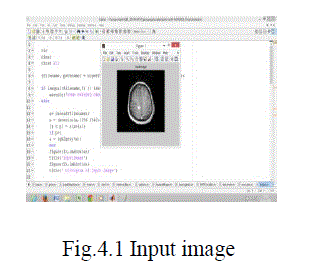 |
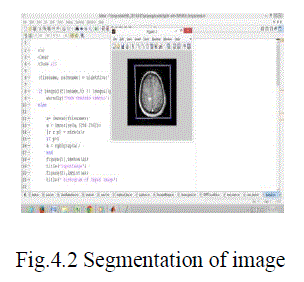 |
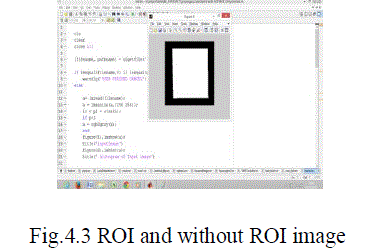 |
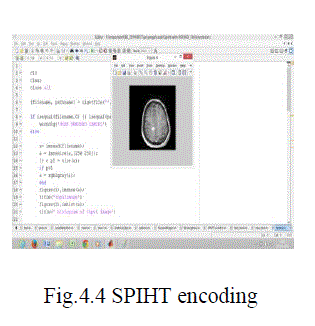 |
| Figure 4.1 |
Figure 4.2 |
Figure 4.3 |
Figure 4.4 |
|
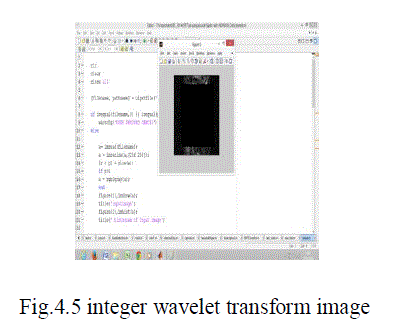 |
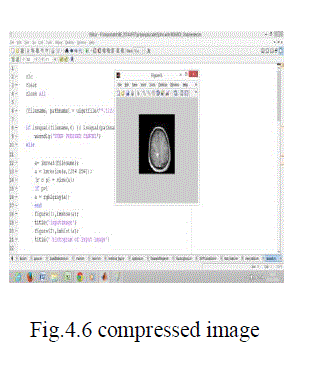 |
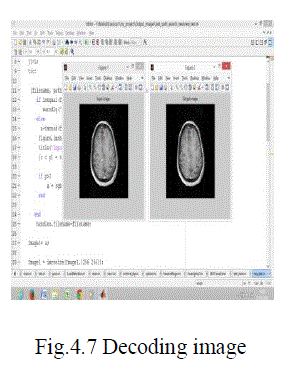 |
| Figure 4.5 |
Figure 4.6 |
Figure 4.7 |
|
References
|
- Amir Said and William A. Pearlman, ‘A New Fast and Efficient Image Codec Based on Set Partitioning in Hierarchical Trees’, " IEEETransactions on Circuits and Systems for Video Technology, vol. 6, pp. 243-250, June 1996.
- Zhongmin Liu, Student Member, IEEE, ZixiangXiong, Member, IEEE, Qiang Wu*, Member, IEEE,Yu-Ping Wang, Member, IEEE, and KennethCastleman, Member, IEEE,’ Cascaded Differential and Wavelet Compression of Chromosome Images,” IEEE TRANSACTIONS ONBIOMEDICAL ENGINEERING, VOL. 49, NO. 4, APRIL 2002
- V. N. Ramaswamy, K. R. Namuduri, and N. Ranganathan,’ Context-Based Lossless Image Coding Using EZW Framework’,” IEEETRANSACTIONS ON CIRCUITS AND SYSTEMS FOR VIDEO TECHNOLOGY, VOL. 11, NO. 4, APRIL 2001
- M. Rabbani and R. Joshi, ‘An Overview of the JPEG 2000 Still Image Compression Standard’, Signal Processing ImageComm., vol. 17, pp.3-48 ,(2002).
- G. Piella, B. Pesquet-Popescu, H.J.A.M. Heijmans. “Adaptive update lifting with a decision rule based on derivative filters”. IEEE SignalProcessing Letters 9, 10 (October 2002), 329–332.
- MónicaPenedo*, William A. Pearlman, Fellow, IEEE, Pablo G. Tahoces, Member, IEEE, Miguel Souto, and Juan J. Vidal,” Region-BasedWavelet Coding Methods for Digital Mammography,” IEEE TRANSACTIONS ON MEDICAL IMAGING, VOL. 22, NO. 10, OCTOBER 2003
- FouadKhelifi, Member, IEEE, Ahmed Bouridane, Senior Member, IEEE, and FatihKurugollu, Senior Member, IEEE,” Joined Spectral Trees forSalable SPIHT-Based Multispectral Image Compression,” IEEE TRANSACTIONS ON MULTIMEDIA, VOL. 10, NO. 3, APRIL 2008
- Garima Chopra and A. K. Pal,” An Improved Image Compression Algorithm Using Binary Space Partition Scheme and GeometricWavelets”, IEEE TRANSACTIONS ON IMAGE PROCESSING, VOL. 20, NO. 1, JANUARY 2011
- Zhijun Fang, NaixueXiong, Member, IEEE, Laurence T. Yang, Member, IEEE, Xingming Sun, and Yan Yang,” Interpolation-Based Direction-Adaptive Lifting DWT and Modified SPIHT for Image Compression in Multimedia Communications,” IEEE SYSTEMS JOURNAL, VOL. 5, NO.4, DECEMBER 2011
- Eva Cavero, A´ lvaroAlesanco, Lena Castro, Jose´ Montoya, Isaac Lacambra, and Jose´ Garc´ia, Member, IEEE,” SPIHT-BasedEchocardiogram Compression: Clinical Evaluation and Recommendations of Use”, IEEE JOURNAL OF BIOMEDICAL AND HEALTHINFORMATICS, VOL. 17, NO. 1, JANUARY 2013
|